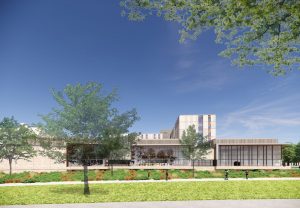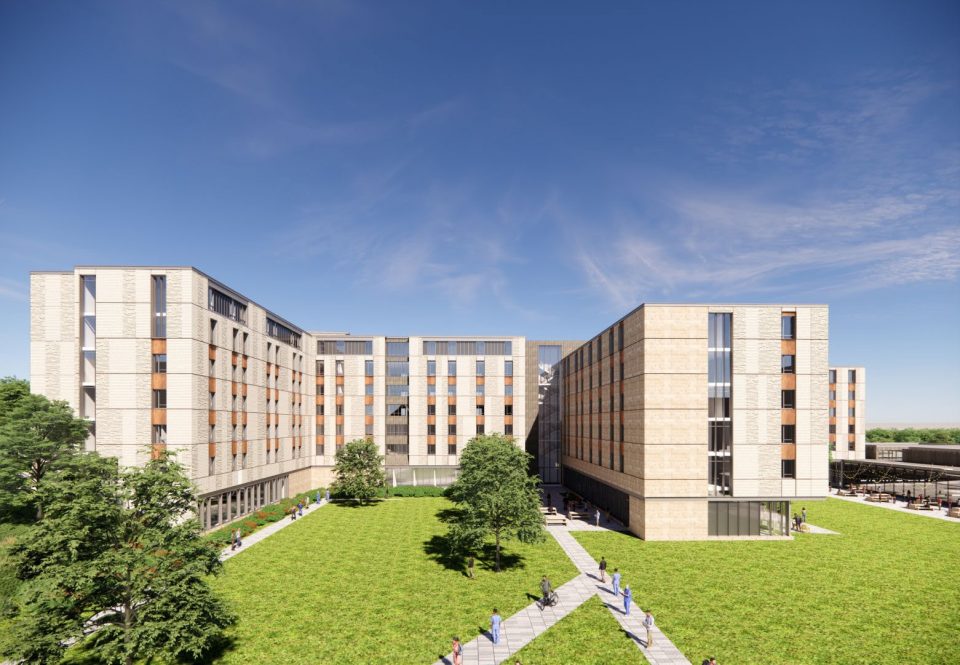The UConn Board of Trustees on Wednesday approved construction of a new residence hall on South Campus, which will help the University update its housing options to better support students in their academic and social experiences.
The board gave approval for University officials to move forward with the construction phase for the proposed residence hall, related utility connections, and landscape improvements.
The residence hall will have 657 beds and a new dining hall of 500 seats and is expected to open in the fall of 2024. It will be built near the existing South Campus Residence Halls, on the corner of Gilbert and Mansfield roads, to create a shared courtyard between that complex and the new building.
Amenity spaces in the new residence hall will include open and private lounges, common spaces, a game room, laundry facilities, bicycle storage, seminar rooms, meeting rooms, and multipurpose spaces.
The dining area will overlook Mirror Lake and will help to alleviate current wait times at other nearby dining halls. Seating areas will have high ceilings and clerestory windows, allowing additional natural light to filter into the space.

The front entrance of the new residence hall will face Gilbert Road and be along campus bus routes, in close proximity to the main pedestrian walkway through campus.
The project budget of $215 million for the South Campus residence hall project will be paid primarily through special obligation bonds issued by UConn, which also pays the debt on them. Funds through state bond funds specifically approved for Next Generation Connecticut projects, and those of the initiative’s predecessor, UConn 2000 will also be used.
The building is designed to meet LEED Gold requirements and Connecticut High Performance Building Standards. Energy demands for the new building will be greatly reduced by an area infrastructure project, currently in the design phase, to install geo-thermal wells that utilize the earth’s stable temperature to reduce energy consumption during heating and cooling seasons. This will be the first such installation on UConn’s Storrs campus, and the geo-thermal wells are part of the University’s initiative to reduce fossil fuel use. The project also includes landscaped storm water management areas that will limit rainwater runoff to Mirror Lake.
The proposal for a new South Campus residence hall has been part of the UConn Master Plan for the Storrs campus since its 2015 update and was also envisioned in the Next Generation Connecticut initiative, which the General Assembly approved in 2013 to catalyze research, academic excellence, and economic growth.
The University received its first design of the proposed residence hall in 2015, but the project was temporarily placed on hold as other Next Gen projects were under way and as uncertainties lingered with the state budget and its appropriation levels for UConn. The original 2015 design was a traditional residence hall, but was reimagined as an all-suite building in response to a student housing study conducted in 2020.
UConn houses 65% to 70% of its undergraduate students on campus each year, one of the highest on-campus residency rates in the nation.
Several trustees have said that envisioning the future of on-campus student housing facilities is one of the most important issues the University will face in coming years, particularly since appropriate student housing is so critical to supporting the kind of life-transformative educational experiences that UConn offers.
UConn currently has 18 residential communities, ranging from the pre-war and historically noteworthy buildings in the East Campus complex to the five-year-old Peter J. Werth Tower in the Hilltop area. About two-thirds of the housing stock consists of traditional double or single units.
Student interest in on-campus living has been historically strong, with about 11,500 to 12,500 students in the residence halls at Storrs in an average year.
In a typical year, almost 60% of UConn’s on-campus students are first-year students and sophomores, with those younger students most heavily concentrated in the traditional units with roommates. However, students at all levels have told the University that they prefer suites and apartment-style living because of the independence, community, and convenience they offer.



